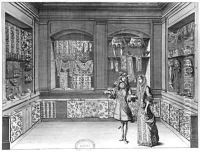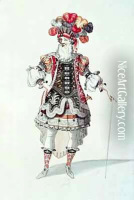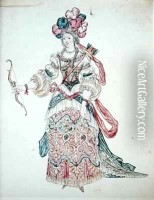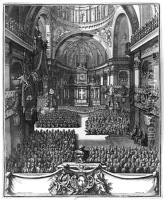Jean II (the Younger) Berain Paintings
Jean II Berain, commonly known as Jean Berain the Younger, was a French designer and engraver. He was born in 1674 in Paris, France, into a family with strong connections to the world of art and design. His father, Jean I Berain (the Elder), was a renowned artist who served as a designer to Louis XIV, and was highly influential in setting the artistic tastes of the period, particularly through his work as a decorator and designer for the royal court. Following in his father’s footsteps, Jean II Berain the Younger continued the family tradition and contributed significantly to the decorative arts during the late 17th and early 18th centuries.
Berain the Younger's career was largely influenced by his father’s reputation and position. After his father's death in 1711, he assumed the role of Dessinateur de la Chambre et du Cabinet du Roi ('Designer to the King's Bedchamber and Cabinet') for Louis XIV. In this capacity, Jean II Berain was responsible for creating a variety of designs, including ornaments, furniture, ballets, pageants, and even designs for the royal funerals and weddings. His style was characteristic of the Régence period, which served as a transition from the grandeur of Louis XIV's late Baroque and classicist style to the more delicate and playful Rococo style that would dominate the 18th century.
Berain the Younger’s artistic output included engravings, etchings, and drawings. His work was known for its intricate detail, elegance, and the sense of whimsy that was to become the hallmark of the Rococo movement. He also worked on theatrical designs and was involved in the staging of court entertainments, a role that he shared with his father before him.
Although not as famous as his father, Jean II Berain's work was still highly valued during his lifetime. He maintained the Berain family's high standards of artistic production and played a role in the evolution of French decorative arts. His designs were influential in spreading the French style across Europe, and his engravings helped disseminate the Régence aesthetic, which was characterized by lighter, more graceful forms and the gradual movement away from the strict geometrical patterns of the earlier Baroque style.
Jean II Berain died in 1726 in Paris. His legacy continued through his own offspring, with his son, Claude III Berain (sometimes referred to as Jean III Berain), also becoming a well-known artist in his own right. The Berain family, through multiple generations, thus left a lasting imprint on the visual arts of France during a period that saw the transition from the grand classical style of Louis XIV to the more intimate and decorative Rococo style.



